The Future of Retail: What Consumers Want From Stores
As uncertainty around COVID-19 restrictions continues to reign across the country, the stakes have never been higher for retailers who now have to reach new operational, experiential, and safety standards to meet the needs of new post-COVID-19 customers.
Retailers have been pondering key existential questions for their business:
What do my customers—old and new—now want and expect in my retail environment?
How do my customers’ new needs, expectations, and behaviors impact the operations of my store?
How can I keep customers and employees safe?
To help answer these important questions, we surveyed both retail customers and leaders to learn where retailers are meeting customer expectations and where they’re not. We also asked about strategies for addressing the future of retail and how technology and software can help in the long term.
Here’s what we’ll cover:
Key Finding #1: Consumers want confidence in their return to physical stores
Key Finding #2: Consumers feel most safe shopping at outdoor spaces
Key Finding #3: Retailers are accelerating adoption of “future retail strategies”
The future of retail stores will be driven by technologies to provide a safe shopping experience
Key Finding #1: Consumers want continued safety and confidence when shopping in-stores
Safety emerged as a big factor for shoppers who are returning in-store. We asked retail consumers what safety measures stores must adopt in order to keep them safe from COVID-19.
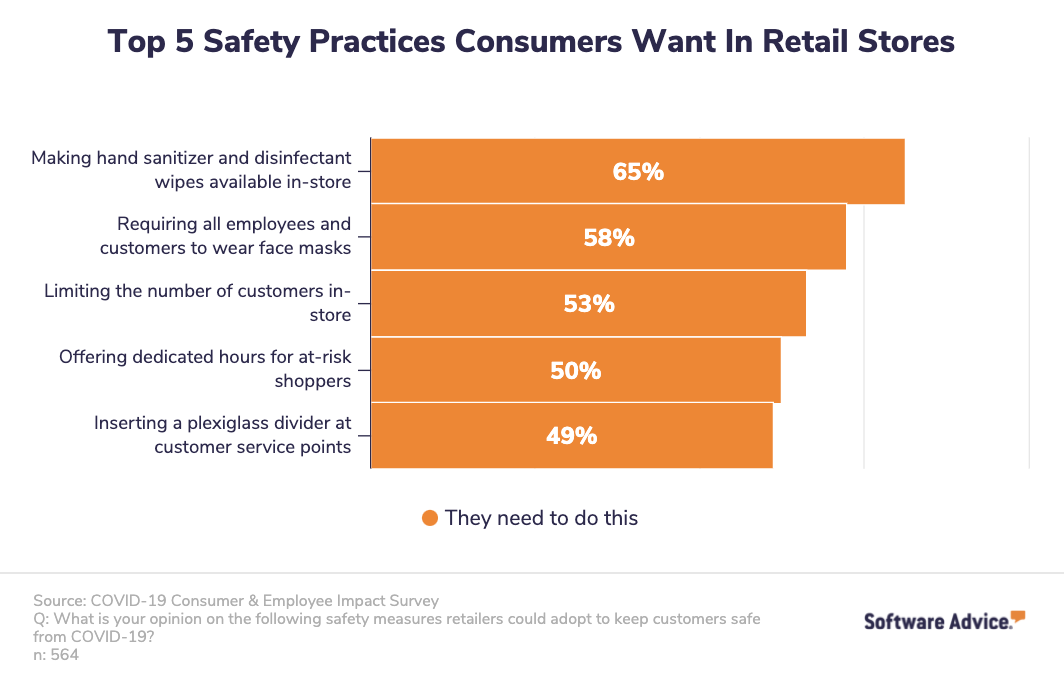
Here are the major takeaways:
Hand sanitizers and disinfectant wipes should be widely available in-store.
Customers and employees should wear face masks.
Number of customers should be limited in-store.
It’s clear that safety is paramount—in fact, 71% of consumers refuse to shop at a retailer that doesn’t follow local safety requirements.
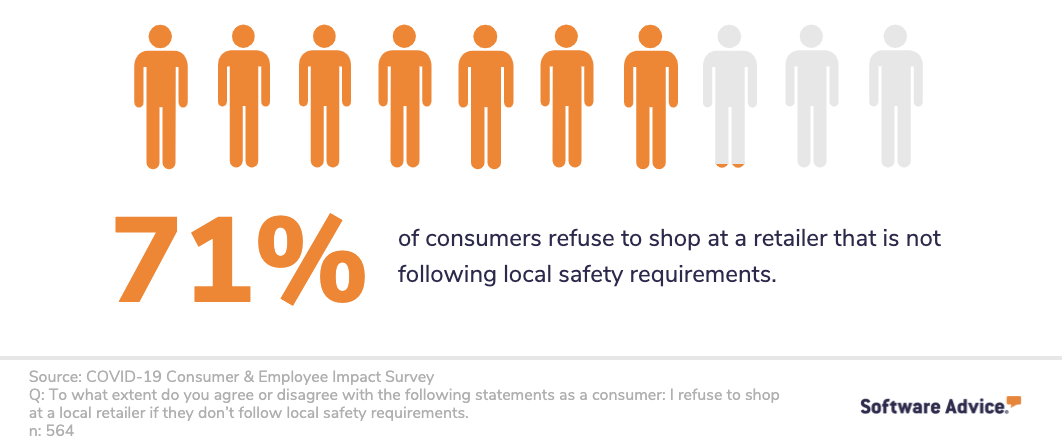
How retailers have responded
In terms of what retailers have already immediately implemented, the following ranked in the top three, in the following order:
Daily rigorous cleaning and disinfecting of surfaces.
Employees and customers need to wear masks.
Communicating sanitary best practices and protocols with in-store signages.
Overall, retailers are doing everything U.S. consumers are asking when it comes to providing them with a safe shopping environment and experience—yet there is still some trepidation.
To address additional concerns, here’s where retailers are making long term investments, specifically when it relates to safety measures and in-store technologies.
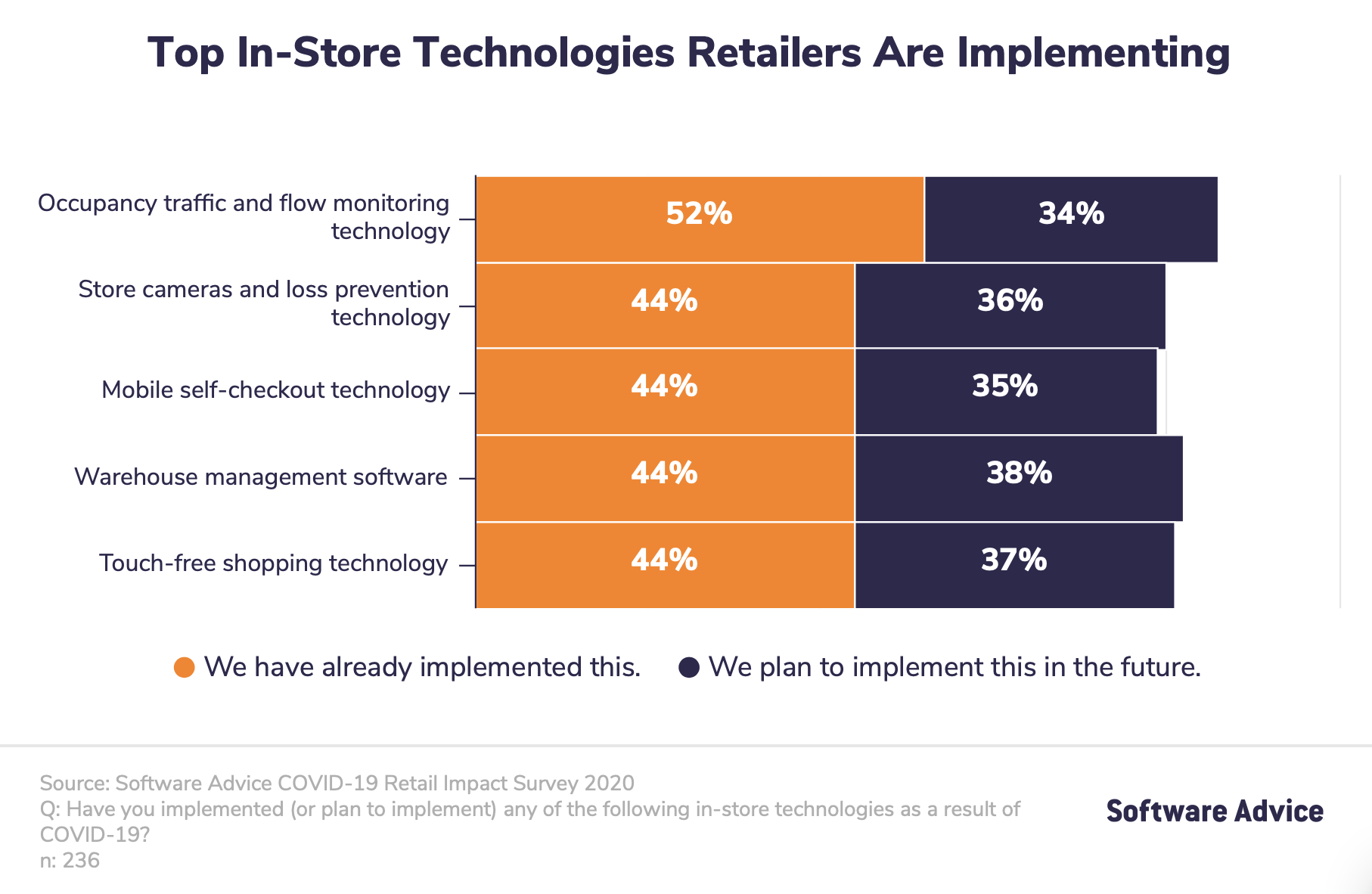
Let’s take a closer look at a few of these.
Occupancy monitoring technology: Assigning employees to count customers manually with a pen and paper or clicker at the door upon entry and exit can result in discrepancies, such as inaccurate count. The need for occupancy monitoring technology is evident as over half of retailers in our survey have turned to it to keep track of their occupancy limits.
Why it’s necessary: Occupancy monitoring is the first step to understanding customer behavior. It can inform your staffing and labor resource decisions and help improve store operations.
Click-and-collect in-store: Often overlooked as a means of obtaining online order, click-and-collect has emerged at the forefront as a way to reduce in-person contact and time spent in-store.
Why it’s necessary: Providing click-and-collect is an important alternative to online delivery. It gives customers the option to engage with your employees in a safe bubble and for retailers, the opportunity to save on costs. 46% of retailers surveyed have already implemented click-and-collect in-store, with 36% planning to implement in the future.
Mobile self-checkout technology: Social distancing poses checkout challenges, such as physical contact around cash and credit cards, and handling of cash. As much as 44% of retailers have implemented mobile self-checkout technology, with another 35% planning to implement it in the future.
Why it’s necessary: Before the pandemic, 40% of consumers said they were more likely to shop at a store offering mobile self-checkout. With both consumers and retailers now more conscious than ever of social distancing and protective measures, contactless technology like mobile self-checkout is key to making shoppers feel safer in stores.
Key Finding #2: Customers feel safest shopping at open and outdoor spaces
Despite drastic changes in consumer behavior and the demand for online shopping, retail stores still have a role to play. The ones that pivot to deliver the best possible retail experiences while ensuring safety for customers will be best equipped to survive and thrive in the post pandemic world.
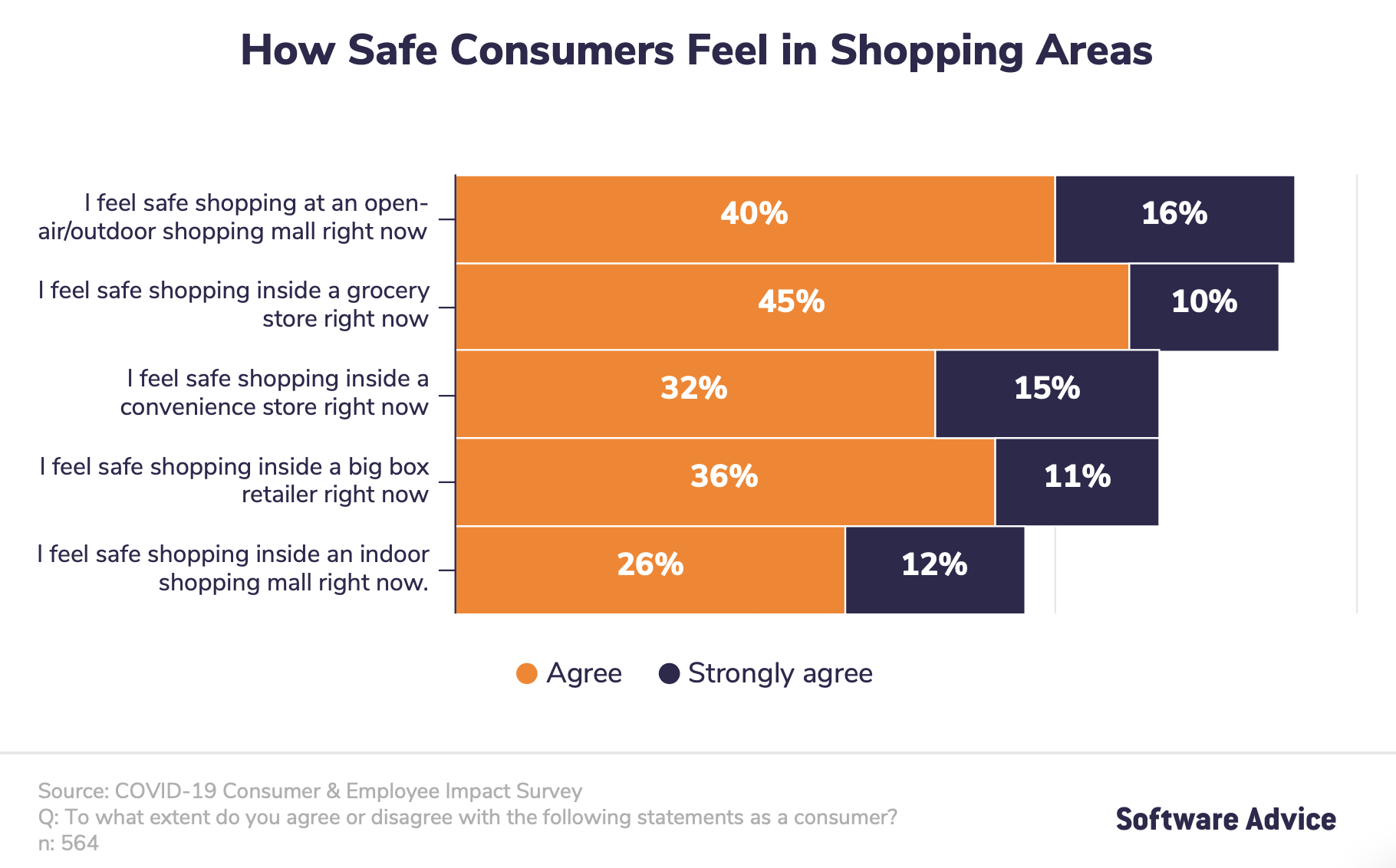
About 38% of consumers agree and strongly agree that they feel safe shopping inside an indoor shopping mall now, while over half (56%) of consumers surveyed say they feel safest shopping at an open air and outdoor shopping mall.
As consumers venture out, they will be seeking out safe spaces and avoiding tight and cramped spaces. The concept of outdoor shopping will be preferred over enclosed spaces, as the results of our survey suggest.
How retailers have responded
Retailers recognize consumers’ want for social distancing options. 50% say they have already expanded to outdoor retail spaces, while nearly a quarter say expansion plans are in the works. That demonstrates that a good number of retailers are looking to diversify their outlet offerings in the future.
Not every retailer has the option to move or shift to outdoor spaces. To address consumer concerns of social distancing, retailers say they’re planning to roll out the following:
46% of retailers plan to implement a virtual queueing system
39% of retailers plan to implement buy online, pickup in-store and/or curbside pickup
34% of retailers plan to implement occupancy traffic and flow monitoring technology
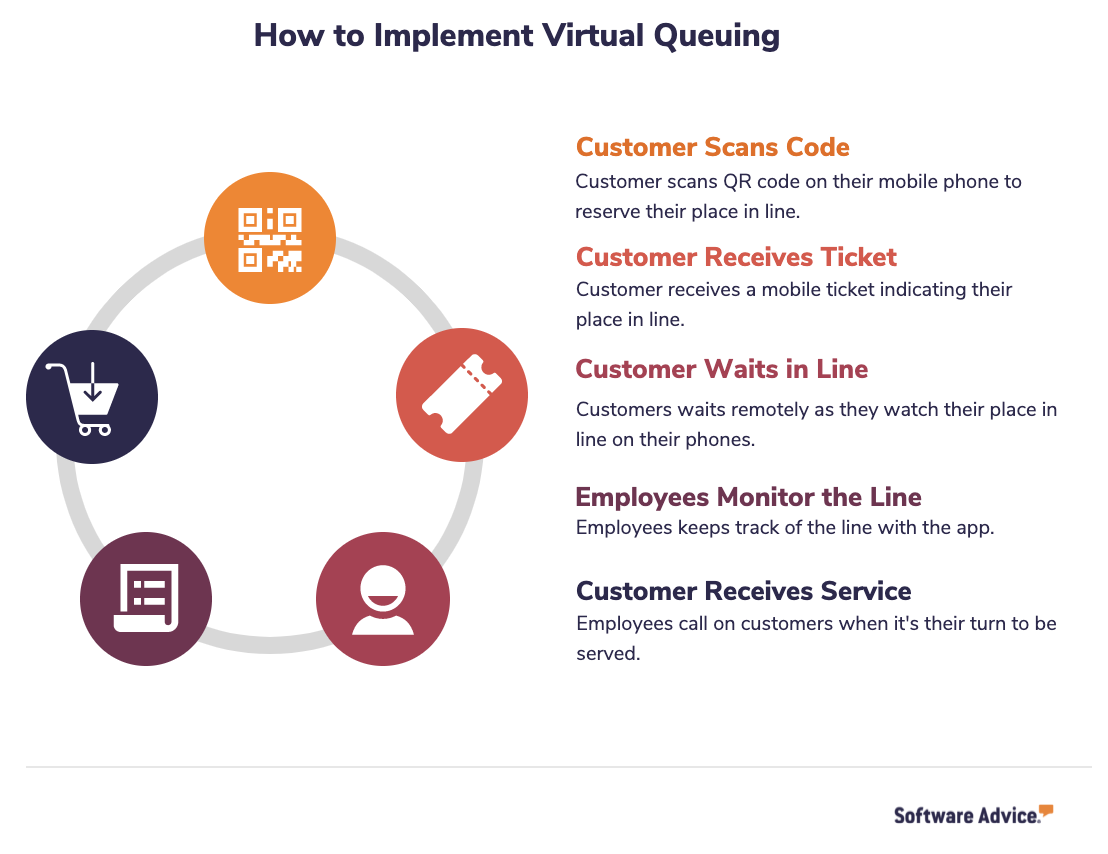
By reducing the number of consumers waiting in stores, virtual queuing helps eliminate the need for queues inside and outside of stores, while at the same time providing an experience that makes customers feel safe. Some retail queue management systems also have the ability to provide a contactless click and collect service.
For example, customers can arrive at the store, check-in with a web link or QR code to inform store teams of their arrival, wait by the entrance or curbside while their orders are being prepared and brought out to them.
Key Finding #3: Retailers are accelerating adoption of “future retail strategies”
Across the board, retailers have increased their efforts in establishing and expanding their ecommerce presence and delivery to improve their online shopping experience and become more efficient with sales.
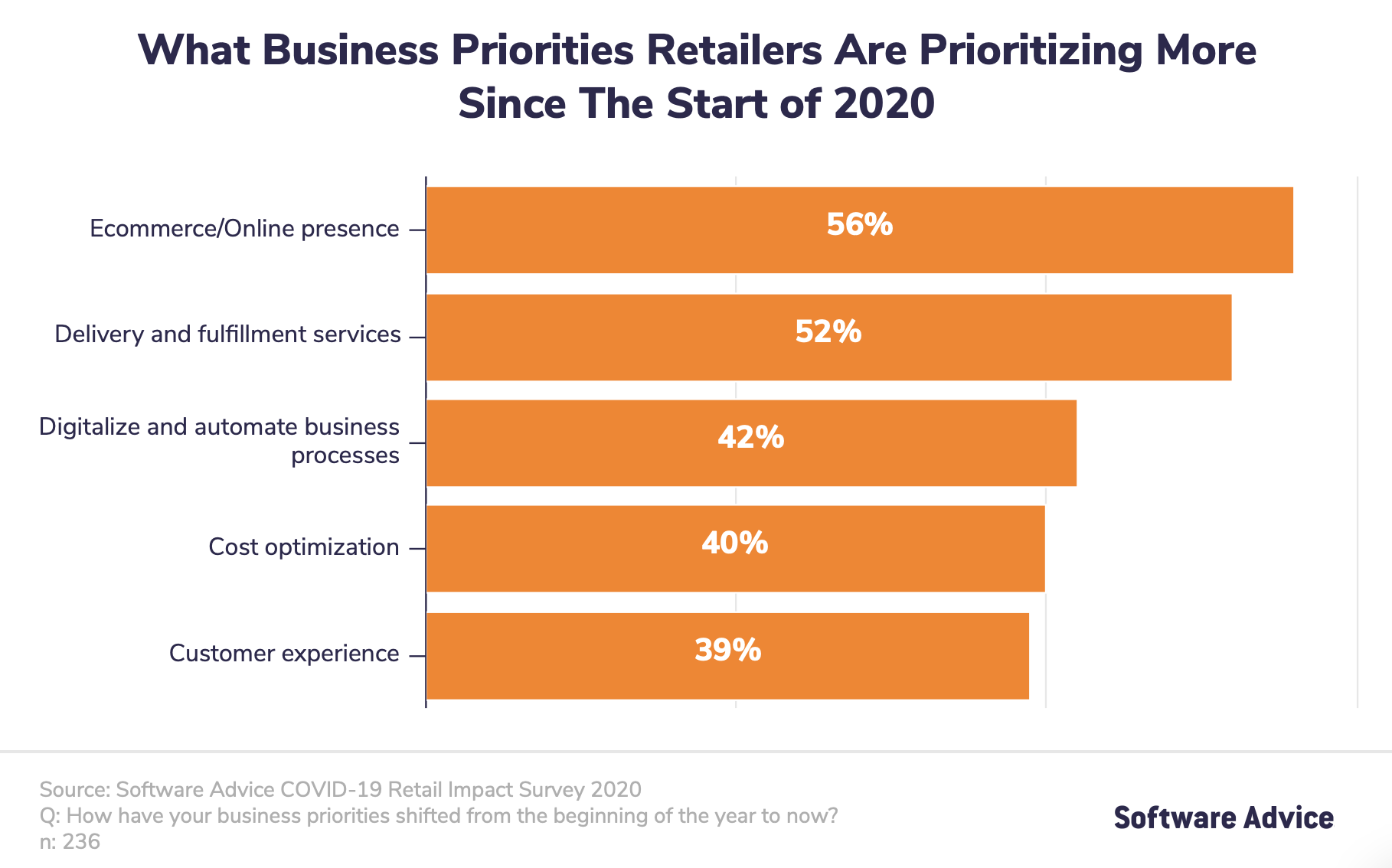
Asked about how their top three business priorities have shifted from the beginning of the year:
56% of retailers are prioritizing their ecommerce and online presence more.
52% of retailers are also prioritizing delivery and fulfillment services from online orders and curbside pickup.
42% of retailers digitalize and automate business processes.
Once viewed by many retailers as a “future strategy,” sales channels and fulfillment services, such as ecommerce, BOPIS, click-and-collect, and curbside pickup are fast becoming must-have services that are being expected and used by consumers.
How retailers have responded
Activity in BOPIS surged as much as 208% in the first few weeks of April, compared to 2019. The majority of retailers recognize that and are investing with increased urgency.
Retailers are expanding their selling avenues online and making sure their offerings in delivery, BOPIS/click-and-collect services provide a consistent and reliable digital experience across channels.
Will this demand for ecommerce and its various fulfillment options continue? 73% of consumers surveyed in a separate Software Advice survey indicated that they will probably and most definitely continue shopping online after the pandemic ends.
How can smaller retailers compete with the likes of Amazon and Walmart to provide BOPIS, curbside pickup and same day delivery options?
They can do so by providing the “last mile delivery” answer. This can come in the form of repurposing their stores into mini fulfillment centers to support online orders. By converting your retail space to meet delivery needs, this places products in customers’ hands faster than ever.
The future of retail stores will be driven by technologies to provide a safe shopping experience
We’ve shared a lot about what customers are expecting of stores, and what retailers like yourself are putting in place now and in future to address new expectations.
As they adopt new business practices and models, retailers will have to turn to technology to meet changing demand in this new era.
Looking for more resources?
Learn how to transform your business in a new, online world: Read articles about how to reinvent your business, rebalance your budget, and reopen your doors.
For other retail research, best practices, and trends, check out our blog.
Lastly, to learn more about software tools, or any of the software categories that can help your retail business survive and thrive during this era, set up an appointment to talk to one of our retail software advisors, who will help you find the right software to suit your needs and budget.
Software Advice COVID-19 Retail Impact Survey 2020
The Software Advice COVID-19 HR Impact Survey was conducted in September 2020. We surveyed 429 retail “leaders,” defined as retail VPs, retail directors, retail managers, or any other role with retail leadership responsibilities, or any other role with retail leadership responsibilities at U.S.-based businesses. We worded the questions to ensure that each respondent fully understood the meaning and the topic at hand.
Software Advice COVID-19 Consumer Impact Survey 2020
The Software Advice COVID-19 Employee Impact Survey was conducted in May 2020. We surveyed 564 respondents within the U.S. We worded the questions to ensure that each respondent fully understood the meaning and the topic at hand.